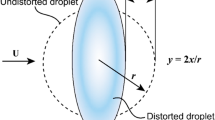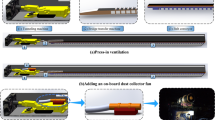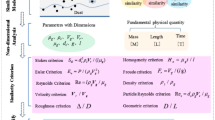Abstract
The efficiency of mine excavation has been significantly enhanced by continuing improvements in tunneling capabilities; however, this has also resulted in serious environmental pollution and greater safety risks for workers. To ensure safe production, the focus of this study is on the effect of varying the air pressure and the distance between the air pressure cylinder and the side wall settings on dust dispersion behavior and dust control in excavated tunnels. We also investigated temporal-spatial dust diffusion rules in tunnels by combining numerical simulation data with field measurement results. Through further analysis, when the pressure air volume and the exhaust air volume are both equal to 250 m3/min, the dust diffusion distance could be fitted as: \({L}_{t}=-4E-09{t}^{6}+1E-06{t}^{5}-0.0002{t}^{4}+0.0107{t}^{3}-0.3219{t}^{2}+5.018t-2.535\). When the exhaust air volume is equal to 250 m3/min, dust control effects were improved as the pressure air volume decreased, becoming optimal when the pressure air volume dropped to 150 m3/min. Under these conditions, areas of high dust pollution were contained within 16 m of the cutting face, and the dust diffusion distance satisfied the formula: \({L}_{s}=2E-06{q}^{3}+0.001{q}^{2}-0.0413q+5.0286\). When the pressure air volume is fixed, the change of the distance between the pressure air cylinder and the side wall has little effect on the dust diffusion. When the distance is 1.5 m, the dust control effect is the best, and the high dust pollution area is controlled within 14 m of the cutting surface. This alleviated dust pollution to a certain degree, thereby enhancing the air quality and ensuring safer production. This study provides a new understanding of the environmentally sustainable development of tunnels and is of great significance for clean production.















Similar content being viewed by others
Data availability
All data generated or analyzed during this study are included in this published article (and its supplementary information files).
Abbreviations
- Q C :
-
Exhaust airflow rate of the exhaust duct (m3/min)
- Q Y :
-
Press-in airflow rate of the pressure duct (m3/min)
- Q FJ :
-
Airflow rate of the dust removal fan (m3/min)
- D Y :
-
Distance between the pressure duct and the coal wall (m)
- L t :
-
Dust diffusion distance (m)
- t :
-
Time (s)
- L s :
-
Dust spread distance (m)
- q :
-
Press-in airflow rate of the pressure duct (m3/min)
References
Amorim JH, Rodrigues V, Tavares R, Valente J, Borrego C (2013) CFD modelling of the aerodynamic effect of trees on urban air pollution dispersion. Sci Total Environ 461:541–551
Argyropoulos CD, Markatos NC (2015) Recent advances on the numerical modelling of turbulent flows. Appl Math Model 39:693–732
Balduzzi F, Bianchini A, Ferrara G, Ferrari L (2016) Dimensionless numbers for the assessment of mesh and timestep requirements in CFD simulations of Darrieus wind turbines. Energy 97:246–261
Bao Q, Nie W, Liu CQ, Zhang HH, Wang HK, Jin H, Yan JY, Liu Q (2020) The preparation of a novel hydrogel based on crosslinked polymers for suppressing coal dusts. J Clean Prod 249:119343
Benni S, Tassinari P, Bonora F, Barbaresi A, Torreggiani D (2016) Efficacy of greenhouse natural ventilation: environmental monitoring and CFD simulations of a study case. Energy and Buildings 125:276–286
Brodny J, Tutak M (2018) Exposure to harmful dusts on fully powered longwall coal mines in Poland. Int J Environ Res Public Health 15:16
Brosh T, Kalman H, Levy A (2014) Accelerating CFD-DEM simulation of processes with wide particle size distributions. Particuology 12:113–121
Cai P, Nie W, Hua Y, Wei WL, Jin H (2018) Diffusion and pollution of multi-source dusts in a fully mechanized coal face. Process Saf Environ 118:93–105
Cai XJ, Nie W, Yin S, Liu Q, Hua Y, Guo LD, Cheng L, Ma QX (2021) An assessment of the dust suppression performance of a hybrid ventilation system during the tunnel excavation process: numerical simulation. Process Saf Environ 152:304–317
Chang P, Xu G, Zhou F, Mullins B, Abishek S (2019) Comparison of underground mine DPM simulation using discrete phase and continuous phase models. Process Saf Environ Prot 127:45–55
Chen XF, Guo C, Song JX, Wang X, Cheng JH (2019) Occupational health risk assessment based on actual dust exposure in a tunnel construction adopting roadheader in Chongqing. China Building and Environment 165:10
Feng Q (2010) Using hybrid ventilation technology to reduce dust concentration in comprehensive excavation work. MINE CONSTRUCTION TECHNOLOGY 31:3
Gong X, Jia C, Sun K, Cui J, Lei K, Xue Y et al (2019) Distribution law and prediction model of dust concentration under airflow adjustment in fully mechanized heading face. Math Probl Eng 2019:1–17
Guo L, Nie W, Yin S, Liu Q, Hua Y, Cheng L et al (2020) The dust diffusion modeling and determination of optimal airflow rate for removing the dust generated during mine tunneling. Build Environ 178:106846
Han FW, Liu J (2018) Flow field characteristics and coal dust removal performance of an arc fan nozzle used for water spray. PLoS ONE 13:16
Han FW, Zhang JY, Zhao Y, Han JH (2019) Experimental investigation on the interaction process between coal particles and foam. AIP Adv 9:8
Hargreaves DM, Lowndes IS (2007) The computational modeling of the ventilation flows within a rapid development drivage. Tunn Undergr Space Technol 22:150–160
Hu SY, Feng GR, Ren XY, Xu G, Chang P, Wang Z et al (2016) Numerical study of gas-solid two-phase flow in a coal roadway after blasting. Adv Powder Technol 27:1607–1617
Hu SY, Liao Q, Feng GR, Huang YS, Shao H, Fan YR et al (2019) Numerical study of gas-solid two-phase flow around road-header drivers in a fully mechanized excavation face. Powder Technol 344:959–969
Hu SY, Wang Z, Feng GR (2015) Temporal and spatial distribution of respirable dust after blasting of coal roadway driving faces: a case study. Minerals 5:679–692
Hua Y, Nie W, Guo LD, Cai XJ, Cheng L (2021) The control effect of 3D spiral wind-curtain generator on respirable dust pollution during tunnelling process. Environ Sci Pollut R
Hua Y, Nie W, Liu Q, Peng H, Wei W, Cai P (2020) The development and application of a novel multi-radial-vortex-based ventilation system for dust removal in a fully mechanized tunnelling face. Tunn Undergr Space Technol 98:103253
Hua Y, Nie W, Wei W, Liu Q, Liu Y, Peng H (2018) Research on multi-radial swirling flow for optimal control of dust dispersion and pollution at a fully mechanized tunnelling face. Tunn Undergr Space Technol 79:293–303
Huang QM, Wu B, Liu Y, Guo ZG, Wang G, Sun LL (2021) Experimental and simulation investigations of the impact of polyacrylamide on CBM ad-/desorption[J]. J Petrol Sci Eng 208:109300
Kampa M, Castanas E. Human health effects of air pollution. Environmental pollution (Barking, Essex : 1987) 2008; 151: 362–7.
Krasnov H, Katra I, Novack V, Vodonos A, Friger MD (2015) Increased indoor PM concentrations controlled by atmospheric dust events and urban factors. Build Environ 87:169–176
Kurnia JC, Sasmito AP, Mujumdar AS (2014) CFD simulation of methane dispersion and innovative methane management in underground mining faces. Appl Math Model 38:3467–3484
Li XC, Li Q, Zhang D, Jia BB, Luo HQ, Hu YF (2015) Model for induced airflow velocity of falling materials in semi-closed transfer station based on similitude theory. Adv Powder Technol 26:236–243
Li XC, Wei T, Wang DX, Hu HB, Kong LZ, Xiang W (2016) Study of gas liquid two-phase flow patterns of self-excited dust scrubbers. Chem Eng Sci 151:79–92
Liu CY, Nie W, Liu XF, Hua Y, Zhou WW, Yu FN, Niu WJ, Sun N, Xue QQ (2021b) Behavior of the particulate matter (PM) emitted by trackless rubber-tyred vehicle (TRTV) at an idle speed under different movement conditions and ventilation optimization. Sci Total Environ 783:147008
Liu N, Sun LL, Qin BT, Zhang SH, Du WZ (2021c) Evolution of pore and fracture of coal under heating–freezing effects: an experimental study. Fuel 306:121618
Liu Q, Nie W, Hua Y, Peng H, Liu C, Wei C (2019a) Research on tunnel ventilation systems: dust diffusion and pollution behaviour by air curtains based on CFD technology and field measurement. Build Environ 147:444–460
Liu Q, Nie W, Hua Y, Peng H, Ma H, Yin S et al (2019b) Long-duct forced and short-duct exhaust ventilation system in tunnels: formation and dust control analysis of pressure ventilation air curtain. Process Saf Environ Prot 132:367–377
Liu Q, Cheng WM, Liu LS, Hua Y, Guo LD, Nie W (2021a) Research on the control law of dust in the main ventilation system in excavated tunnels for cleaner production. Build Environ 205:108282
Liu XF, Nie W, Hua Y, Liu CY, Guo LD, Ma WW (2021d) Behavior of diesel particulate matter transport from subsidiary transportation vehicle in mine. Environ Pollut 270:116264
Ma Q, Nie W, Yang S, Xu C, Peng H, Liu Z et al (2020) Effect of spraying on coal dust diffusion in a coal mine based on a numerical simulation. Environ Pollut 264:114717
Nie W, Wei W, Cai P, Liu Z, Liu Q, Ma H et al (2018) Simulation experiments on the controllability of dust diffusion by means of multi-radial vortex airflow. Adv Powder Technol 29:835–847
Niu WJ, Nie W, Yuan MY, Bao Q, Zhou WW, Yan JY, Yu FN, Liu CY, Sun N, Xue QQ (2021) Study of the microscopic mechanism of lauryl glucoside wetting coal dust: environmental pollution prevention and control. J Hazard Mater 412:125223
Parra MT, Villafruela JM, Castro F, Méndez C (2006) Numerical and experimental analysis of different ventilation systems in deep mines. Build Environ 41:87–93
Qiao ZW, Liu Z, Zhang XT, Zhang HY, Li ZX, Li D (2021) Effect of roughness on the force and erosion of cylindrical structures under water-sand two phase flow. J Shandong Univ Sci Technol (Natural Science) 40(3):44–49
Ramponi R, Blocken B (2012) CFD simulation of cross-ventilation for a generic isolated building: impact of computational parameters. Build Environ 53:34–48
Roy D, Singh G, Seo YC. Coal mine fire effects on carcinogenicity and non-carcinogenicity human health risks. Environmental Pollution 2019; 254.
Shi G, Liu M, Guo Z, Hu F, Wang D (2017) Unsteady simulation for optimal arrangement of dedusting airduct in coal mine heading face. J Loss Prev Process Ind 46:45–53
Singh RVK, Tripathi DD, Mohalik NK, Khalkho A, Pandey J, Mishra RK. Environmental issues due to fire in coal mines: its impact and suggestions for implementing precautionary and control measures. In: Singh VP, Yadav S, Yadava RN, editors. Environmental Pollution. 77, 2018, pp. 27–35.
Souza FJD, Salvo RDV, Martins DADM (2012) Large eddy simulation of the gas–particle flow in cyclone separators. Sep Purif Technol 94:61–70
Sun LL, Wang HS, Zhang C, Zhang SH, Liu N, He ZL (2021) Evolution of methane ad-/desorption and diffusion in coal under in the presence of oxygen and nitrogen after heat treatment. J Nat Gas Sci Eng 95:104196
Torano J, Torno S, Menendez M, Gent M (2011) Auxiliary ventilation in mining roadways driven with roadheaders: validated CFD modelling of dust behaviour. Tunn Undergr Space Technol 26:201–210
Wang HT, Xuan WF, Zhang ZZ, Qin BT (2019) Experimental investigation of the properties of dust suppressants after magnetic-field treatment and mechanism exploration. Powder Technol 342:149–155
Wang HP, Gao M, Gao YC, Chen QS (2021a) Experimental study on dynamic characteristics of calcareous sand solidified by polymer. J Shandong Univ Sci Technol (Natural Science) 40(4):56–64
Wang Z, Yin YC, Zhao TB, Ma JM, Wu WB (2021b) Numerical simulation study on bolting mechanism and support control of soft rock roadway. J Shandong Univ Sci Technol (Natural Science) 40(3):35–43
Wang Y, Luo G, Geng F, Li Y, Li Y (2015) Numerical study on dust movement and dust distribution for hybrid ventilation system in a laneway of coal mine. J Loss Prev Process Ind 36:146–157
Widiatmojo A, Sasaki K, Sugai Y, Suzuki Y, Tanaka H, Uchida K et al (2015) Assessment of air dispersion characteristic in underground mine ventilation: field measurement and numerical evaluation. Process Saf Environ Prot 93:173–181
Xiu ZH, Nie W, Yan JY, Chen DW, Cai P, Liu Q, Du T, Yang B (2020) Numerical simulation study on dust pollution characteristics and optimal dust control air flow rates during coal mine production. J Clean Prod 248:119197
Xu CW, Nie W, Liu ZQ, Peng HT, Yang SB, Liu Q (2019) Multi-factor numerical simulation study on spray dust suppression device in coal mining process. Energy 182:544–558
Xu G, Luxbacher KD, Ragab S, Xu JL, Ding XH (2017) Computational fluid dynamics applied to mining engineering: a review. Int J Min Reclam Environ 31:251–275
Yan JY, Nie W, Xiu ZH, Yuan MY, Zhou WW, Bao Q, Peng HT, Niu WJ, Yu FN (2021) Development and characterization of a dust suppression spray agent based on an adhesive NaAlg−gln−poly/polysaccharide polymer. Sci Total Environ 785:147192
Yang SB, Nie W, Lv SS, Liu ZQ, Peng HT, Ma X, Cai P, Xu CW (2019) Effects of spraying pressure and installation angle of nozzles on atomization characteristics of external spraying system at a fully-mechanized mining face. Powder Technol 343:754–764
Yin S, Nie W, Liu Q, Hua Y. Transient CFD modelling of space-time evolution of dust pollutants and air-curtain generator position during tunneling. Journal of Cleaner Production 2019; 239.
Yu FN, Nie W, Zhou WW, Yuan MY, Yan JY, Hua Y, Bao Q, Niu WJ (2021) Performance evaluation of Mn-Ce/cordierite catalyst modified by green surfactant to remove NOx in underground mines at low temperatures. J Environ Chem Eng 9:106499
Yuan MY, Nie W, Zhou WW, Yan JY, Bao Q, Guo CJ, Tong P, Zhang HH, Guo LD (2020) Determining the effect of the non-ionic surfactant AEO9 on lignite adsorption and wetting via molecular dynamics (MD) simulation and experiment comparisons. Fuel 278:118339
Zhang H, Nie W, Liang Y, Chen JG, Peng HT (2021a) Development and performance detection of higher precision optical sensor for coal dust concentration measurement based on Mie scattering theory. Opt Laser Eng 144:106642
Zhang X, Nie W, Peng HT, Chen DW, Du T, Yang B, Niu WJ (2021b) Onboard air curtain dust removal method for longwall mining: Environmental pollution prevention. J Environ Chem Eng 9:106387
Zhu YF, Wang DM, Shao ZL, Xu CH, Zhu XL, Qi XY et al (2019) A statistical analysis of coalmine fires and explosions in China. Process Saf Environ Prot 121:357–366
Funding
This work has been funded by the National Natural Science Foundation of China (no. 51874191 and 52174191), the National Key R&D Program of China (2017YFC0805201), the Qing Chuang Science and Technology Project of Shandong Province University (2020KJD002), and the Tai Shan Scholars Project Special Funding (TS20190935).
Author information
Authors and Affiliations
Contributions
WN: conceptualization, methodology, software, investigation, writing—original draft, review, and editing; LC: resources, writing—review and editing, supervision, data curation; SY: software, review and editing; QL: software, review and editing; YH: data curation, review and editing; LG: data curation, review and editing; XC: data curation, review and editing; QM: data curation, review and editing; CG: data curation, review and editing.
Corresponding author
Ethics declarations
Ethics approval and consent to participate
Not applicable.
Consent for publication
Not applicable.
Competing interests
The authors declare no competing interests.
Additional information
Responsible Editor: Philippe Garrigues
Publisher’s note
Springer Nature remains neutral with regard to jurisdictional claims in published maps and institutional affiliations.
Rights and permissions
About this article
Cite this article
Nie, W., Cheng, L., Yin, S. et al. Effects of press-in airflow rate and the distance between the pressure duct and the side wall on ventilation dust suppression performance in an excavating tunnel. Environ Sci Pollut Res 29, 19404–19419 (2022). https://doi.org/10.1007/s11356-021-16825-8
Received:
Accepted:
Published:
Issue Date:
DOI: https://doi.org/10.1007/s11356-021-16825-8




